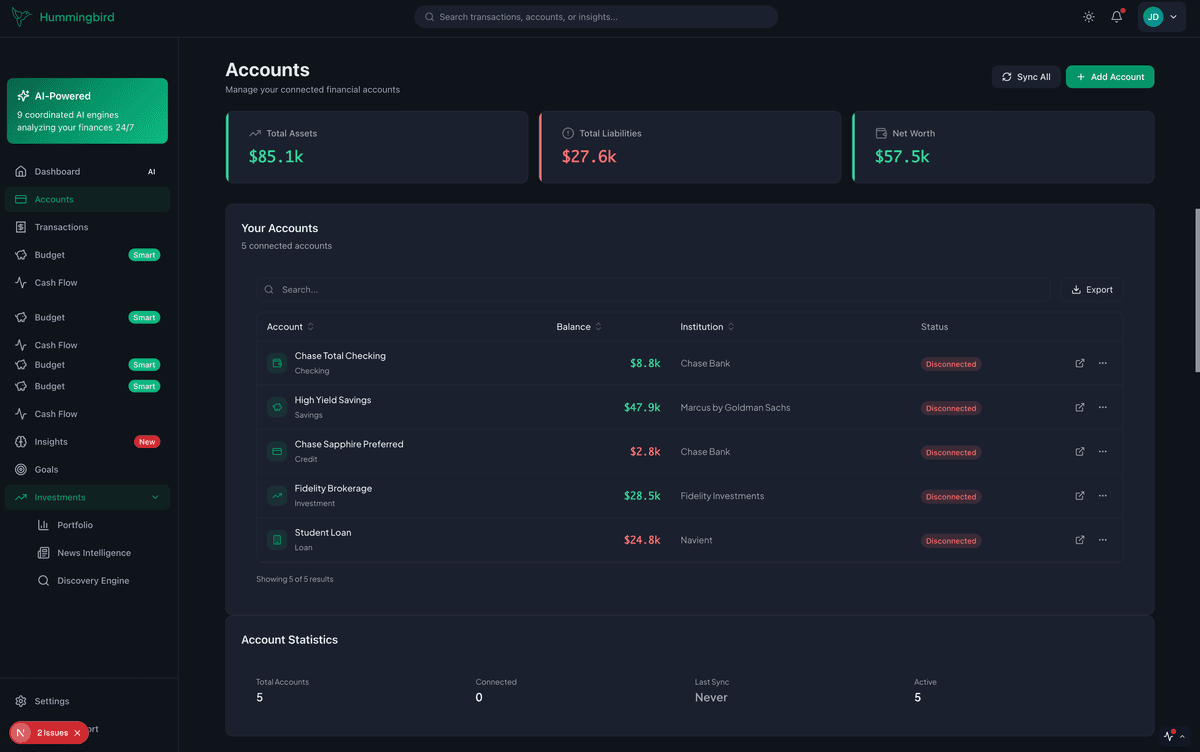hummingbird financial
wealth ops — 9 AI engines understanding why you spend, not just what
problem
budgeting apps don't build wealth. They track spending but miss emotional patterns that drive financial decisions.
solution
9 engines for categorization, surplus routing, goal funding, and rules-based investing — all with privacy-first local processing.

Hummingbird Dashboard: Multi-account financial overview with AI-powered categorization and insights.
architecture
9-engine system:
- observer: learns spending patterns and triggers
- emotional: maps stress patterns to purchases
- cash flow: forecasts 18 months ahead
- debt: optimizes payoff strategies
- investment: identifies tactical opportunities
- budget: maintains health scores
- goal: provides AI coaching
- tax: optimizes deductions
- acting: coordinates all engines
design & process reflection
this project evolved from an experimental fintech prototype into a sophisticated ai-powered financial intelligence platform. the transformation required balancing ambitious technical capabilities with honest, evidence-based claims while focusing on genuine user value.
key pm challenges & decisions
achieving 96.2% ai accuracy without sacrificing transparency
built trust in ai-powered financial categorization by implementing confidence scoring for every ai decision with human-in-the-loop fallbacks.
outcome: users trust the system because they understand when and why ai makes decisions.
real banking integration while maintaining security
balanced powerful features with financial data security by choosing established apis (plaid, alpaca) with comprehensive audit trails and encryption.
outcome: production-ready security that doesn't compromise user experience.
multi-agent architecture without overengineering
designed specialized agents only where parallel processing provided clear user benefits.
outcome: 10x faster financial analysis through genuine parallel processing gains.
core pm learnings
financial software requires different product thinking: every pm decision has compliance, security, and accuracy implications that don't exist in typical web applications.
ai transparency builds user trust: users need confidence scores and fallback options, not black-box magic. the best ai products explain their reasoning.
multi-agent systems need clear value propositions: architectural complexity is only justified when it delivers tangible user benefits like parallel processing or specialized intelligence.
honest documentation is the best marketing: evidence-based claims with transparent limitations build more trust than polished marketing language.
what made this unique
real implementation depth
30,000+ lines of production-ready code with validated performance metrics
genuine ai innovation
natural language financial queries and emotional spending analysis
transparent approach
complete honesty about capabilities with evidence-based claims
pm lessons for fintech
proof: rule audit log, category accuracy vs. bank export, Q1 pilot results